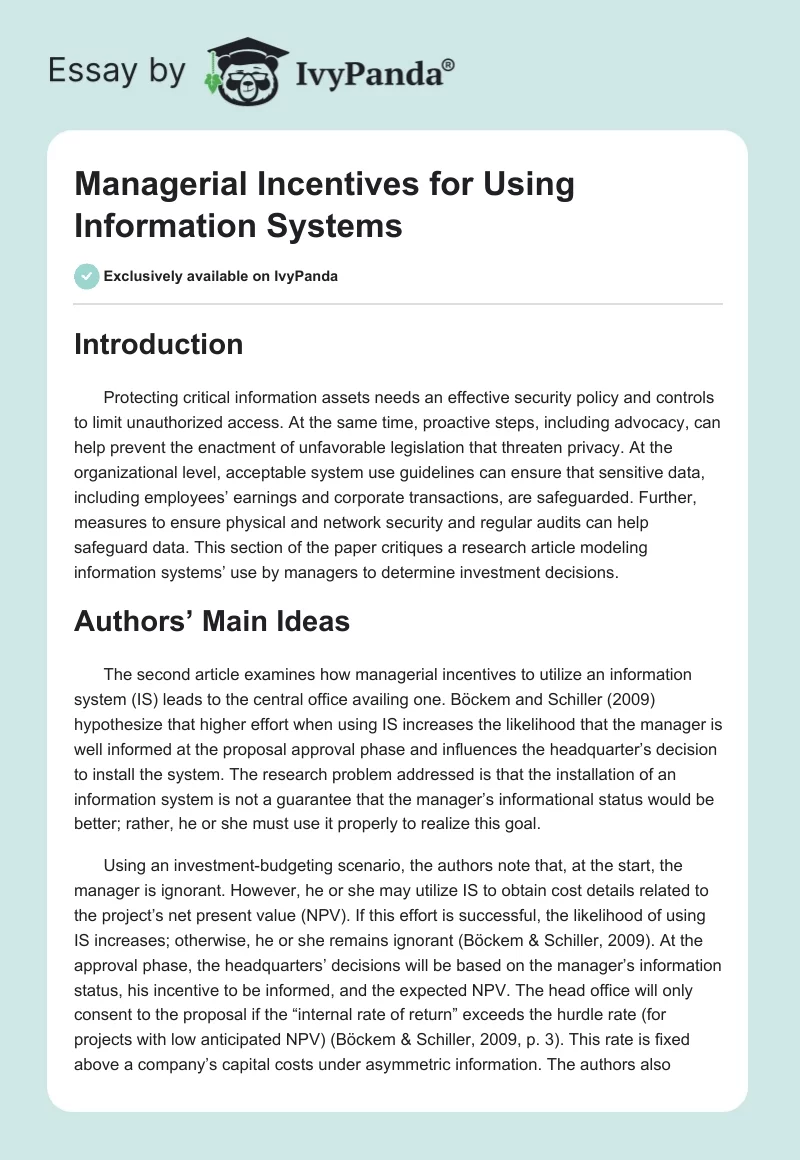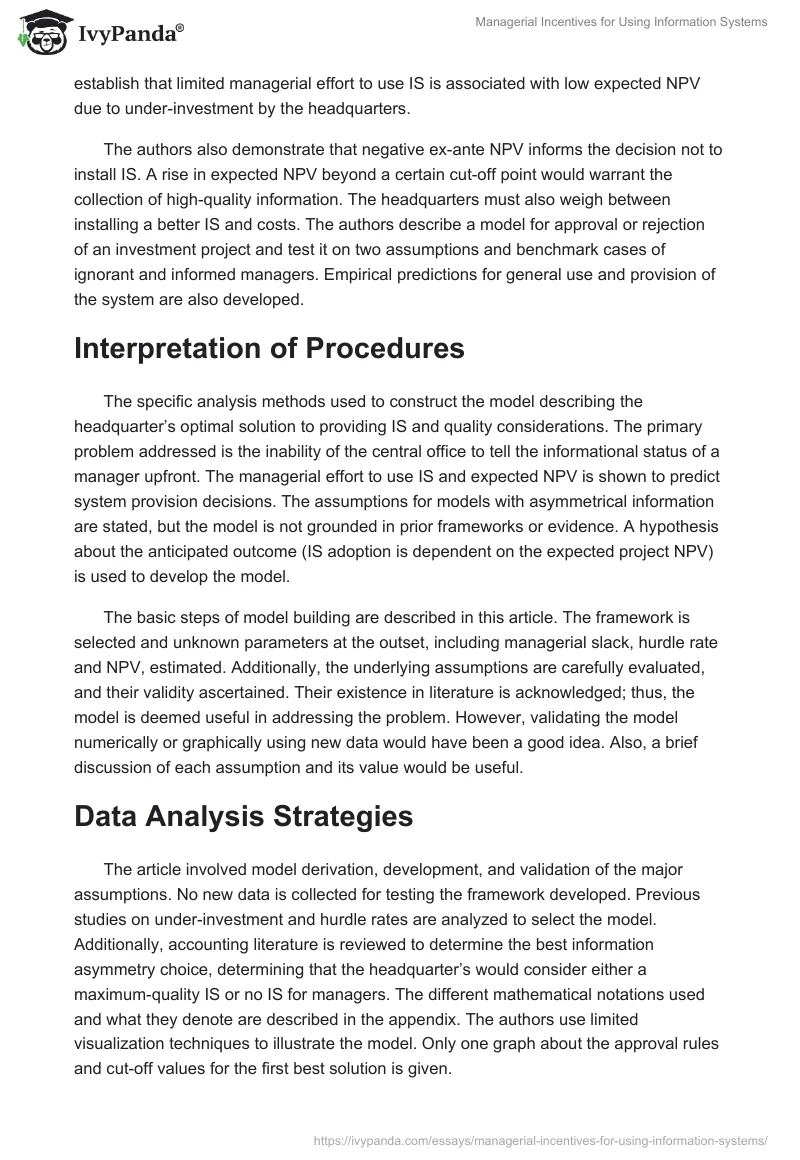Introduction
Protecting critical information assets needs an effective security policy and controls to limit unauthorized access. At the same time, proactive steps, including advocacy, can help prevent the enactment of unfavorable legislation that threaten privacy. At the organizational level, acceptable system use guidelines can ensure that sensitive data, including employees’ earnings and corporate transactions, are safeguarded. Further, measures to ensure physical and network security and regular audits can help safeguard data. This section of the paper critiques a research article modeling information systems’ use by managers to determine investment decisions.
Authors’ Main Ideas
The second article examines how managerial incentives to utilize an information system (IS) leads to the central office availing one. Böckem and Schiller (2009) hypothesize that higher effort when using IS increases the likelihood that the manager is well informed at the proposal approval phase and influences the headquarter’s decision to install the system. The research problem addressed is that the installation of an information system is not a guarantee that the manager’s informational status would be better; rather, he or she must use it properly to realize this goal.
Using an investment-budgeting scenario, the authors note that, at the start, the manager is ignorant. However, he or she may utilize IS to obtain cost details related to the project’s net present value (NPV). If this effort is successful, the likelihood of using IS increases; otherwise, he or she remains ignorant (Böckem & Schiller, 2009). At the approval phase, the headquarters’ decisions will be based on the manager’s information status, his incentive to be informed, and the expected NPV. The head office will only consent to the proposal if the “internal rate of return” exceeds the hurdle rate (for projects with low anticipated NPV) (Böckem & Schiller, 2009, p. 3). This rate is fixed above a company’s capital costs under asymmetric information. The authors also establish that limited managerial effort to use IS is associated with low expected NPV due to under-investment by the headquarters.
The authors also demonstrate that negative ex-ante NPV informs the decision not to install IS. A rise in expected NPV beyond a certain cut-off point would warrant the collection of high-quality information. The headquarters must also weigh between installing a better IS and costs. The authors describe a model for approval or rejection of an investment project and test it on two assumptions and benchmark cases of ignorant and informed managers. Empirical predictions for general use and provision of the system are also developed.
Interpretation of Procedures
The specific analysis methods used to construct the model describing the headquarter’s optimal solution to providing IS and quality considerations. The primary problem addressed is the inability of the central office to tell the informational status of a manager upfront. The managerial effort to use IS and expected NPV is shown to predict system provision decisions. The assumptions for models with asymmetrical information are stated, but the model is not grounded in prior frameworks or evidence. A hypothesis about the anticipated outcome (IS adoption is dependent on the expected project NPV) is used to develop the model.
The basic steps of model building are described in this article. The framework is selected and unknown parameters at the outset, including managerial slack, hurdle rate and NPV, estimated. Additionally, the underlying assumptions are carefully evaluated, and their validity ascertained. Their existence in literature is acknowledged; thus, the model is deemed useful in addressing the problem. However, validating the model numerically or graphically using new data would have been a good idea. Also, a brief discussion of each assumption and its value would be useful.
Data Analysis Strategies
The article involved model derivation, development, and validation of the major assumptions. No new data is collected for testing the framework developed. Previous studies on under-investment and hurdle rates are analyzed to select the model. Additionally, accounting literature is reviewed to determine the best information asymmetry choice, determining that the headquarter’s would consider either a maximum-quality IS or no IS for managers. The different mathematical notations used and what they denote are described in the appendix. The authors use limited visualization techniques to illustrate the model. Only one graph about the approval rules and cut-off values for the first best solution is given.
Technical analysis is used to test the assumptions and compute the best quality level of IS. However, a training dataset is not given, making it difficult to estimate model parameters. Additionally, the cross-validation of these functions and constraints is not based on data. Although the theoretical model considers two benchmark cases and different IS usage scenarios, without testing it on a dataset, the validity of the parameters may not be ascertained. Quantitative data analysis using regression coefficients or descriptive statistics may be useful to validate the model. Additionally, since the model is predictive, data would help minimize bias and prediction error.
Conclusion/Recommendation
The article examined a predictive model development for IS use by managers. It develops a model for central office decisions to invest in IS based on managerial informational status. Thematic analysis using varied information sources, earlier frameworks, and theories is a procedure used to support model assumptions. Additionally, the conclusions are drawn from the model parameters after testing it. The use of new data to test model assumptions is recommended to validate it.
Reference
Böckem, S., & Schiller, U. (2009). Managerial use of an information system. SSRN Electronic Journal, 1-39. doi: 10.2139/ssrn.1420160


